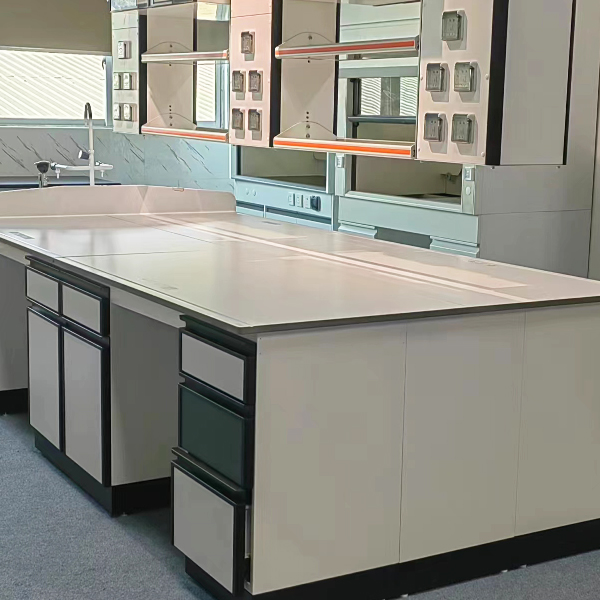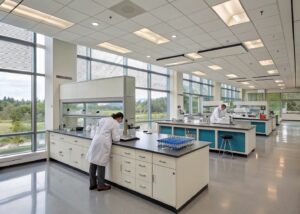Table of Contents
The laboratory of the future is no longer just about beakers and microscopes. As the digital age continues to evolve, smart lab furniture is emerging as a revolutionary trend that integrates modern technology with traditional lab setups. By incorporating Internet of Things (IoT) devices, automated systems, and other advanced technologies, these intelligent workstations enhance efficiency, improve safety, and create a more dynamic work environment.
As a manufacturer of lab furniture , this article will delve into how smart lab furniture is transforming laboratory workspaces and provide insights into the benefits of integrating cutting-edge technology into lab furniture. Whether you’re planning to upgrade an existing lab or design a new one, this article will offer valuable tips for ensuring your lab is future-ready.
The Rise of Smart Lab Furniture: What’s Driving the Trend?
The shift toward smart labs reflects broader changes in how industries operate. With the increasing use of automation, IoT devices, and data-driven systems, laboratories are embracing digital transformation to stay ahead. Smart lab furniture plays a crucial role in this transition, as it combines traditional functionality with innovative features to optimize workflow, enhance safety, and improve data accuracy.
Key Drivers of Smart Lab Furniture:
- Efficiency: Automated systems and IoT-enabled workstations streamline processes, reducing manual labor and improving overall productivity.
- Data Integration: Smart furniture allows for real-time data collection, offering better insights into equipment usage, lab conditions, and safety protocols.
- Enhanced Collaboration: Connected lab environments enable better communication between researchers, fostering collaboration through digital platforms.
- Cost Savings: Automation and improved energy efficiency reduce operating costs and help labs stay within budget.
This trend is especially prominent in research-intensive industries such as pharmaceuticals, biotechnology, and environmental science, where accuracy, speed, and innovation are paramount.
How Integrated Technology Improves Lab Efficiency
The cornerstone of smart lab furniture is its ability to integrate with various technologies, making everyday tasks smoother and more efficient. Imagine a lab workstation that can communicate directly with your lab management software, track inventory, monitor environmental conditions, and even provide automated alerts for maintenance tasks—all in real-time.
Examples of Integrated Technology:
- IoT Sensors: Smart furniture equipped with IoT sensors can monitor temperature, humidity, and air quality, ensuring that the lab environment remains within optimal parameters for experiments.
- Automated Storage: With automated storage systems, you can track chemicals, samples, and equipment, ensuring that your inventory is up to date and stored safely.
- Data Collection: IoT-enabled workstations can record data such as the usage of lab instruments, energy consumption, and more, which can be analyzed to improve workflow efficiency.
- Wireless Charging and Connectivity: Smart workstations come equipped with wireless charging stations for devices, reducing clutter and keeping your team connected throughout the day.
By integrating technology into lab furniture, labs can improve accuracy and efficiency, reduce human error, and make better use of available resources.
Safety Enhancements with Smart Lab Furniture
Safety is a top priority in any laboratory setting, and smart furniture can significantly improve the safety protocols in place. By incorporating automated systems and real-time monitoring, smart lab furniture reduces the risk of accidents and ensures compliance with safety regulations.
Safety Features in Smart Lab Furniture:
- Automated Shutdowns: IoT-enabled workstations can automatically shut down certain instruments or systems if hazardous conditions are detected, such as a gas leak or temperature spike.
- Real-Time Alerts: Smart furniture can send alerts to lab staff or supervisors when specific conditions are breached, such as unsafe chemical storage temperatures or improperly sealed fume hoods.
- Emergency Response Integration: In the event of an emergency, smart lab furniture can be connected to the lab’s emergency response systems, automatically alerting local authorities or triggering evacuation protocols.
- Access Control: Digital lock systems integrated into storage units and workstations can ensure that only authorized personnel have access to sensitive materials or dangerous equipment.
With these safety enhancements, laboratories can not only protect their staff but also ensure compliance with local and federal safety regulations, reducing liability and risk.
Energy Efficiency and Sustainability in Smart Labs
Another significant advantage of smart lab furniture is its potential to promote energy efficiency and sustainability. Labs are notorious for consuming vast amounts of energy due to specialized equipment and constant environmental controls, but smart furniture offers solutions to reduce energy waste.
Sustainability Features in Smart Lab Furniture:
- Energy Monitoring: Integrated sensors track energy consumption at the workstation level, allowing lab managers to identify areas where energy use can be reduced.
- Smart Lighting Systems: IoT-enabled lighting can adjust automatically based on occupancy or natural light availability, minimizing unnecessary energy consumption.
- Energy-Saving Modes: Equipment integrated into smart lab furniture can be set to enter energy-saving modes during periods of inactivity, reducing overall energy usage without compromising performance.
- Sustainable Materials: Many manufacturers now produce smart lab furniture using eco-friendly materials such as recycled metals and sustainable woods, reducing the environmental footprint of lab construction.
By investing in smart lab furniture, labs can reduce their environmental impact, achieve energy savings, and even qualify for green certifications such as LEED (Leadership in Energy and Environmental Design).
Future-Proofing Your Lab with Modular and Customizable Designs
One of the most valuable aspects of smart lab furniture is its flexibility. As lab technology continues to evolve, it’s crucial to have a workspace that can adapt to new equipment, workflows, and personnel needs. Modern smart furniture is designed to be modular and customizable, making it easy to future-proof your lab for ongoing innovation.
Benefits of Modular Smart Lab Furniture:
- Scalability: Smart workstations and storage units can be reconfigured or expanded as your lab grows, allowing for easy adaptation to new projects and technologies.
- Plug-and-Play Solutions: Modular smart furniture often comes with plug-and-play systems that allow new equipment to be integrated quickly and seamlessly.
- Custom Designs: Labs can work with manufacturers to design smart furniture that meets their specific needs, whether it’s for unique equipment, sensitive materials, or specialized workflows.
- Long-Term Durability: High-quality, modular smart furniture is built to last, reducing the need for frequent replacements and minimizing long-term costs.
By incorporating modular designs, smart lab furniture ensures that your lab can continue to evolve and remain efficient, regardless of future changes in technology or staffing.
Conclusion: Smart Lab Furniture is the Future of Laboratory Efficiency
As laboratories continue to adopt digital and automated solutions, smart lab furniture is becoming essential for creating a highly efficient, safe, and future-ready work environment. From IoT integration and real-time data monitoring to enhanced safety protocols and energy efficiency, smart furniture is transforming the way labs operate.
If you’re looking to upgrade your lab or design a new one, consider the long-term benefits of investing in smart lab furniture. By embracing these innovative solutions, you’ll be equipping your lab with the tools it needs to stay ahead of the curve, improve productivity, and meet the ever-evolving demands of modern research and industry.




